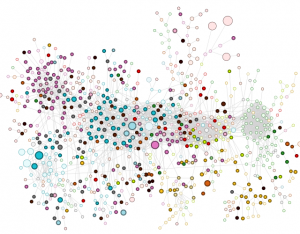The Product Space
MIT-Harvard collaboration.
Main authors: Ricardo Hausmann and César A. Hidalgo.
Other contributors: Bailey Klinger, Albert-Laszlo Barabasi, Sebastian Bustos, Sarah Chung, Juan Jimenez, Alex Simoes, Muhammed Yildirim

The Product Space is a network connecting two products if two or more countries export both products in significant quantities. The products included are the ones classified either under the SITC classification (Standard International Trade Classification) or the HS classification (Harmonized Commodity Description and Coding System). For example, a product can be “Electronic Integrated Circuits” or “Soya Beans”.
The Product Space is built with the following procedure. First, the products are connected to the countries that export them. For there to be a link between a country and a product, the country needs to export the product more than the world average. This is a bipartite network, a network with two types of nodes. The Product Space is then obtained by projecting the product-country bipartite network onto a product-product unipartite network. The meaning of a link here is that two products are connected if the same countries “specialize” in making them, so they require the same capabilities to be made. Next, product communities are calculated, using network-based community discovery, and they represent a proposal for a new capability-based product classification.
The full procedure is described in details in the following papers:
- “The Product Space Conditions the Development of Nations”, CA Hidalgo, B Klinger, A-L Barabasi, R Hausmann. Science (2007) 317: 482-487 (PDF – External link);
- “The Building Blocks of Economic Complexity”, CA Hidalgo, R Hausmann. Proc. Natl. Acad. Sci. (2009) 106(26):10570-10575 (PDF – External link);
- “The Atlas of Economic Complexity “, R Hausmann, CA Hidalgo, S Bustos, M Coscia, S Chung, J Jimenez, A Simoes, MA Yildirim. Puritan Press (2011). ISBN-10: 0615546625 (PDF – External link).
Download the SITC-based Product Space network.
Download the HS-based Product Space network.
Both packages contain a “nodes” and a “edges” file. The columns are the same for the two packages (with one exception), and they are always tab separated.
- Column 1: Product ID (SITC for the SITC network, HS for the HS network, obviously). All IDs have 4 digits.
- Column 2: Product Community.
- Columns 3-4: X and Y coordinates for the layout of the graph.
- Column 5: Node size. It is proportional to its market share, but not linearly (only for layout purposes).
- Column 6: Leamer category (in SITC file), Product Name (in HS file).
- Column 7: Product Name (in SITC file), Node color (in HS file).
- Column 8 (only in SITC file): Node color.
The node color is a map corresponding to node community.
- Column 1: Source Product ID (the Product Space is undirected, but for sake of simplicity I’ll call the first node “source” and the second “target”).
- Columns 2-3: Source Node X and Y.
- Column 4: Target Product ID.
- Columns 5-6: Target Node X and Y.
- Column 7: Width of the link. It’s proportional to its strength. As in the case of the node size, the link width is not linearly connected to its strength and it should be used exclusively for layout purposes.
- Column 8: Color of the link. Carries the same information of the width.
Interactive visualizations of the graph and the treemaps can be found in the official website of the ATLAS book.
